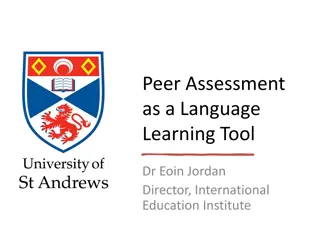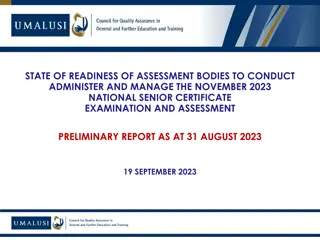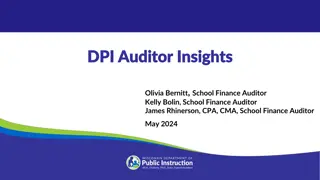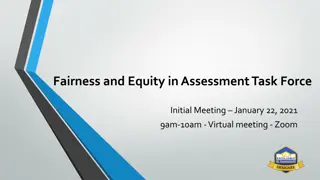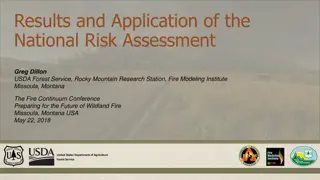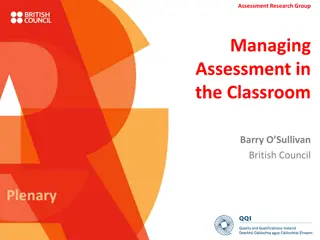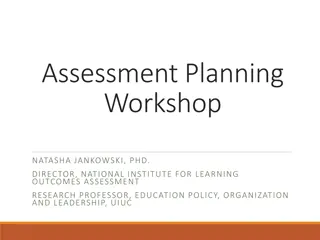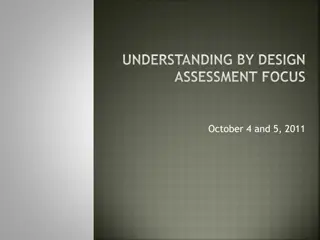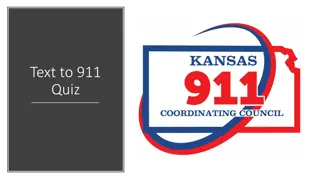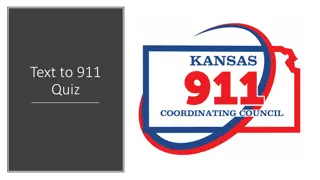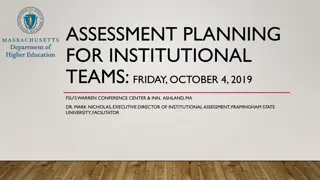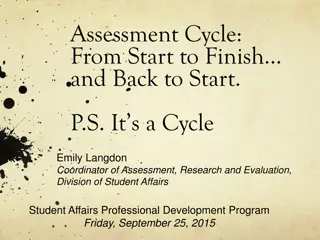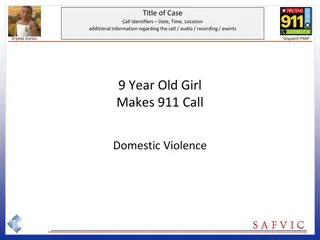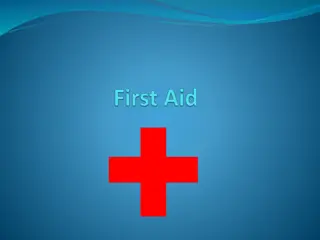Overview of National 911 State Assessment Guidelines
The National 911 State Assessment Guidelines provide a framework for evaluating statewide 911 systems. Developed over two years by a diverse group, these guidelines encompass 83 criteria in nine categories such as Security, Human Resources, Public Education, and Governance. Each guideline includes detailed descriptions, rationale, and guidance for assessors. The assessment is voluntary and is used to identify strengths and areas for improvement in a state's 911 operations.
Download Presentation

Please find below an Image/Link to download the presentation.
The content on the website is provided AS IS for your information and personal use only. It may not be sold, licensed, or shared on other websites without obtaining consent from the author.If you encounter any issues during the download, it is possible that the publisher has removed the file from their server.
You are allowed to download the files provided on this website for personal or commercial use, subject to the condition that they are used lawfully. All files are the property of their respective owners.
The content on the website is provided AS IS for your information and personal use only. It may not be sold, licensed, or shared on other websites without obtaining consent from the author.
E N D
Presentation Transcript
911 State Assessment Overview Kansas 911 Coordinating Council June 2018 .
Background: National 911 State Assessment Guidelines Modeled after EMS assessments, which have been used for many years to help EMS systems identify strengths and leverage resources to make improvements 911 Assessment Guidelines were developed by diverse representatives from the 911 community over two years as part of National 911 Assessment Guidelines Working Group (NAGWG) Successful pilot assessment conducted in Delaware Successful assessment conducted in North Carolina Assessments are done at the request of the state and are voluntary Process assesses the operation of the statewide 911 system Please note: The assessment is not a technical evaluation. The final report is the property of the state. 1
Overview of National 911 State Assessment Guidelines The state is not compared to other states but compared against an objective benchmark to assess the status of a particular function within the overall operation of a statewide 911 system A total of 83 guidelines exist in nine categories Next Security / Continuity of Operations Human Resources / Training Functional and Operational Planning Generation 911 Maturity Model Public Education Statutory and Regulatory Evaluation Governance Standards 9 7 8 5 7 27 5 9 6 83 Guidelines The guidelines illustrate functions of effective 911 systems, but do not dictate exactly how to achieve an end result 2
Guideline Example Each guideline includes a description of the levels of criteria, the rationale for why the guideline is relevant and important to the assessment, and guidance for the assessors Guideline SR1: The statutory environment provides for comprehensive statewide 9-1-1 coordination. Minimum Criteria Advanced Criteria Statute(s) provides for the roles and responsibilities of statewide 9-1-1 coordination. for input from stakeholders statewide. Rationale: Statewide 9-1-1 coordination helps improve uniform quality service across the state. Lack of comprehensive coordination can increase costs and decrease desirable outcomes. Guidance: Statewide coordination should include all 9-1-1 stakeholders, all 9-1-1 accessible services (e.g., wireline, wireless, Voice over Internet Protocol [VoIP] and emerging technologies) and governmental and non-governmental entities. Comprehensive coordination includes statewide planning, funding support, stakeholder involvement, uniform statewide adherence to established technical and operational standards, influencing policy creation to the benefit of the stakeholders, public education, training, enforcement, rulemaking, procurement authority, grant writing assistance, grant management, dispute resolution, and program evaluation. Superior Criteria Statute(s) provides authority for statewide planning, with a mechanism Statute(s) provides authority and funding. 3
911 State Assessment Benefits and Outcomes Provides a comprehensive appraisal of a statewide 911 system across a diverse set of topics Provides an objective assessment at the national level using a benchmark developed by the 911 community Conducted by a group of experienced 911 peers and leaders within their domain of expertise, who are also developing NG911 networks and systems Identifies strengths and weaknesses within the current 911 system, providing a roadmap for improvement Generated by a neutral, non-profit third-party, the report can confirm/validate the needs of the statewide 911 system Performed onsite, providing an opportunity for state representatives and stakeholders to exchange information and ideas with the assessment team Results can be used to benchmark the state s 911 system and measure future progress The assessment will identify areas of improvement in our existing NG9-1-1 structure. Providing the Kansas 911 Coordinating Council with a roadmap to continue leading the national in Next Generation 9-1-1 4
911 State Assessment Logistics An assessment team will typically consist of 5-7 assessors and administrative support Assessment team spends 5 business days on site completing assessment process National 911 Program State Assist state with assessment planning o Develop local/state PSAP assessment team members Develop an assessment schedule Coordinate (and train as needed) the assessment team o Provide team with guidelines to review (one month prior to assessment) Assist with logistics planning Support the onsite assessment process Facilitate post-assessment process Continue support through resources and check-in with state representatives Initial kick-off meeting State assessment team gathering Engage all stakeholders to ensure commitment to data collection efforts Complete current environment document Plan logistics for on-site assessment (facilities, etc.) Arrange schedules for assessment team o In-person gathering upon assessment team arrival Prepare a state briefing for the assessors Provide comments to draft report and participate in post-assessment activities Reimburse assessment team for expenses (see cost estimate) 5
Sample 911 State Assessment Preparation Schedule 6 9 months *Expected project duration of 6-9 months is varied dependent on the state s preparation needs 6
Sample 911 State Assessment Costs Cost Description Low High Pilot Cost Honorarium Estimated at $200 per day, per assessor $7,000 $7,000 $0 Range: $550 to $850 per flight (for the pilot, some assessors drove while some required airfare) Airfare $3,850 $5,950 $4,866 Hotel (based on GSA per diem) City, State ($113), City, State ($98), St. Paul, MN ($135) Hotel $3,864 $5,460 $3,416 Meals (based on GSA per diem) Richmond, VA ($66), Raleigh, NC ($66), St. Paul, MN ($71) Meals $2,310 $2,485 $2,100 Supplies Assorted Supplies (paper, pens, snacks, etc.) $20 $50 $44 Transportation to and from the airport (pilot included 2 mid-sized rental vehicles and fuel) Local Travel $445 $645 $458 Facilities Rental One or two conference-style meeting rooms for 5 days Range: $100 to $250 per day $500 $2,500 $572 Total $17,989 $24,090 $11,456 Note: Costs based on six assessors and one administrative support person for a 5-day, 4-night assessment period and does not include the Assessment Coordinator. Variations should be expected due to the local economy, state rules, and/or other factors. Many costs could be reduced by using available state resources. For example, using a state or PSAP facility for the meetings, or leveraging state contracts with hotels or caterers, could reduce or eliminate some assessment costs. However, the majority of a state s cost will be in the data gathering effort prior to the assessment. 7
911 State Assessment: Next Steps Approve Voluntary Participation Schedule Kick-off meeting Discuss data collection requirements/efforts Discuss tools available to assist with data collection Discuss logistics (conference space) Review costs Schedule planning discussions Develop assessment schedule 8



